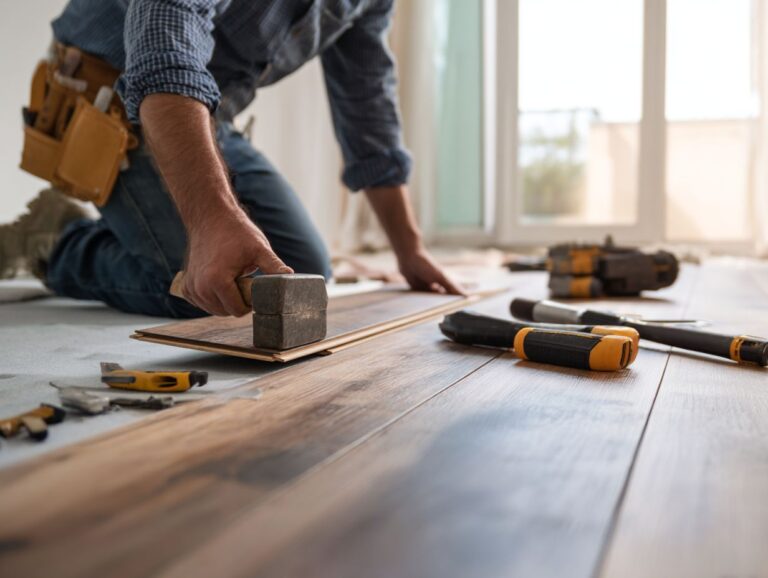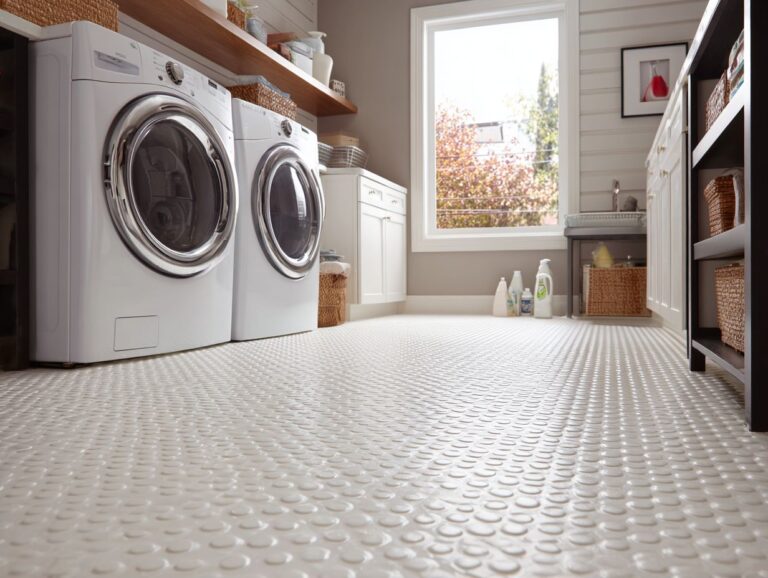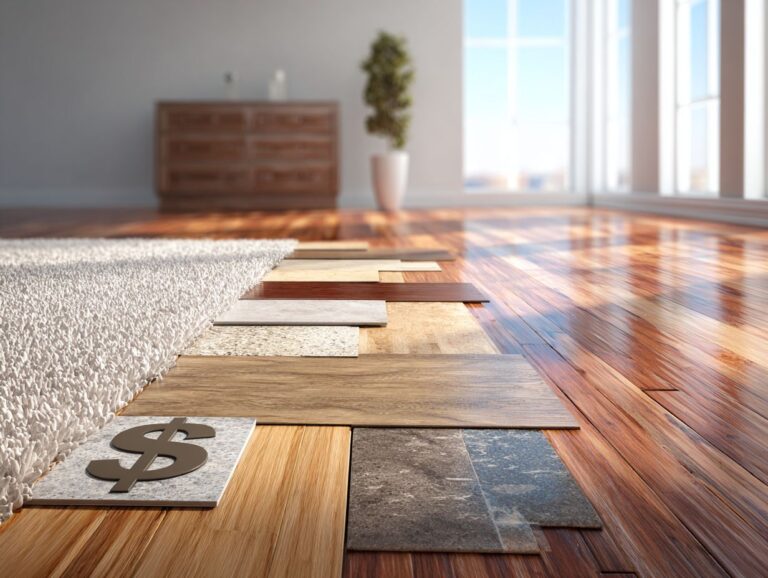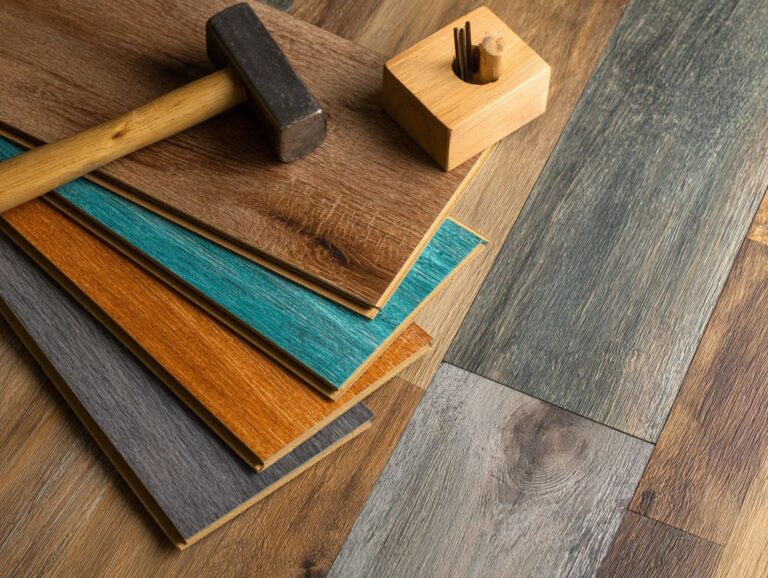Flooring Underlayment Installation – Types and Methods
Knowing about flooring underlayment is important for getting the perfect flooring finish. Whether you’re putting in laminate or vinyl plank flooring, using the right underlayment-such as QuietWalk or QuietBoard-can improve the feel and strength. This guide looks at different options, including FloorLyft Ultra, and provides installation tips to help you complete a perfect hardwood flooring project. Learn how to choose and set up the right underlayment for your situation!
Key Takeaways:
Contents
- Flooring Underlayment Market Data
- Types of Flooring Underlayment
- Choosing the Right Underlayment
- Preparation for Installation
- Installation Methods
- Common Mistakes to Avoid
- Frequently Asked Questions
- What is flooring underlayment and why is it important for installation?
- What are the different types of flooring underlayment?
- What are the benefits of using cork underlayment?
- Can I install flooring underlayment myself?
- What is the difference between floating and attached underlayment?
- How do I know which type of underlayment is best for my flooring?
What is Flooring Underlayment?

Flooring underlayment is the layer of material between the floor covering and the base floor. It offers comfort, adds warmth, and provides strength.
Common materials for flooring underlayment include:
- Foam
- Cork
- Rubber
Foam is light and keeps out moisture, which makes it perfect for laminate or engineered wood floors. Cork, on the other hand, features excellent sound absorption, perfect for multi-level homes and apartments. Rubber underlayment offers superior durability and is often used beneath tile and hardwood for added shock absorption.
Choosing the right underlayment is important. For example, using foam in a basement can cause problems with moisture, while cork is better for reducing noise in a room.
Importance of Underlayment in Flooring
Underlayment plays a critical role in enhancing flooring performance by reducing noise, providing moisture barriers, and ensuring the longevity of the flooring materials.
In homes, using underlayment can significantly reduce the noise from footsteps, making the area quieter, especially in multi-story houses.
In commercial spaces, it aids in thermal insulation, reducing energy costs, particularly in vast open areas.
A good foam underlayment absorbs sound and reduces moisture problems in basements.
When installing tile, using a cement board underlayment provides extra support and prevents cracks over time.
Choosing the correct underlayment can improve both comfort and durability in different uses.
Flooring Underlayment Market Data
Flooring Underlayment Market Data
Market Growth Factors: Projected Market Value
The Flooring Underlayment Market Data offers important information about the market’s expected expansion and possibilities in the next few years. A critical aspect of the data is the anticipated market value in 2025, which is expected to reach $1.4499 billion. This indicates strong demand for flooring underlayment products, which are important for reducing noise, protecting against moisture, and making floors last longer in homes and businesses.
Another important part pointed out is the compound annual growth rate (CAGR) of 3.6% from 2025 to 2033. The consistent growth in this industry looks promising, thanks to more construction work, renovation projects, and a rising demand for high-quality flooring that needs dependable underlayment.
Many reasons explain why this increase is expected:
- Construction Boom: The growth of the construction industry, especially in developing countries, increases the need for flooring underlayment as new buildings and infrastructure projects require dependable flooring options.
- Home Renovations: The increasing number of people upgrading their homes drives market growth because they want to make their homes more comfortable and practical.
- Product Innovation: Improvements in foundation materials and technologies, like environmentally-friendly choices and better soundproofing, draw in consumers who want sustainable and effective flooring options.
Overall, the data shows positive signs for the flooring underlayment market, with growth fueled by building projects, home improvements, and new product developments. Industry participants can take advantage of these opportunities by prioritizing quality, sustainability, and technology improvements to meet the changing needs of both consumers and builders.
Types of Flooring Underlayment
Picking the correct flooring underlayment is important because different kinds offer distinct advantages suited to particular flooring types and installation settings. Worth exploring: Laminate Flooring Underlayment Types – Complete Guide.
Foam Underlayment
Foam underlayment is a well-liked and budget-friendly option because it lessens noise and is easy to install, which makes it a good match for laminate and vinyl floors.
This type of underlayment typically ranges from $0.30 to $0.70 per square foot, allowing for budget-friendly projects.
Its thickness varies, with 3mm to 5mm options offering optimal sound dampening and cushioning.
Easy to install, it often comes in rolls or sheets that can be laid directly beneath the flooring, requiring minimal tools.
Foam underlayment can decrease noise between floors and make walking more comfortable, making it a suitable choice for homes and businesses.
Cork Underlayment
Cork padding is an environmentally friendly option that effectively manages pressure and lessens noise, making it an excellent choice for hardwood and vinyl flooring.
In addition to reducing noise, cork underlayment typically costs between $0.50 and $1.00 per square foot, making it an affordable choice for various projects.
It is also highly sustainable, being harvested from the bark of cork oak trees without harming the tree itself. Recommended applications include use under engineered hardwood, laminate, and tile, where its moisture-resistant properties come into play.
Be mindful of potential drawbacks such as slight odor and susceptibility to mold in damp areas. Using cork underlayment can greatly improve how well your flooring works and how long it lasts.
Rubber Underlayment
Rubber underlayment is renowned for its superior durability and excellent acoustic performance, often used in commercial settings and high-traffic areas.
Rubber underlayment usually costs between $0.80 and $1.50 for each square foot. It offers great soundproofing, which makes it perfect for apartments, offices, and gyms.
Its thickness and density help absorb impact noise, enhancing overall comfort.
Before you install, make sure the surface is clean and dry. Place the underlayment so the edges are touching closely to stop any sound from escaping. It’s also beneficial to use a moisture barrier when applicable, increasing its longevity and effectiveness.
This combination makes rubber underlayment a practical choice for any noise-sensitive environment.
Felt Underlayment
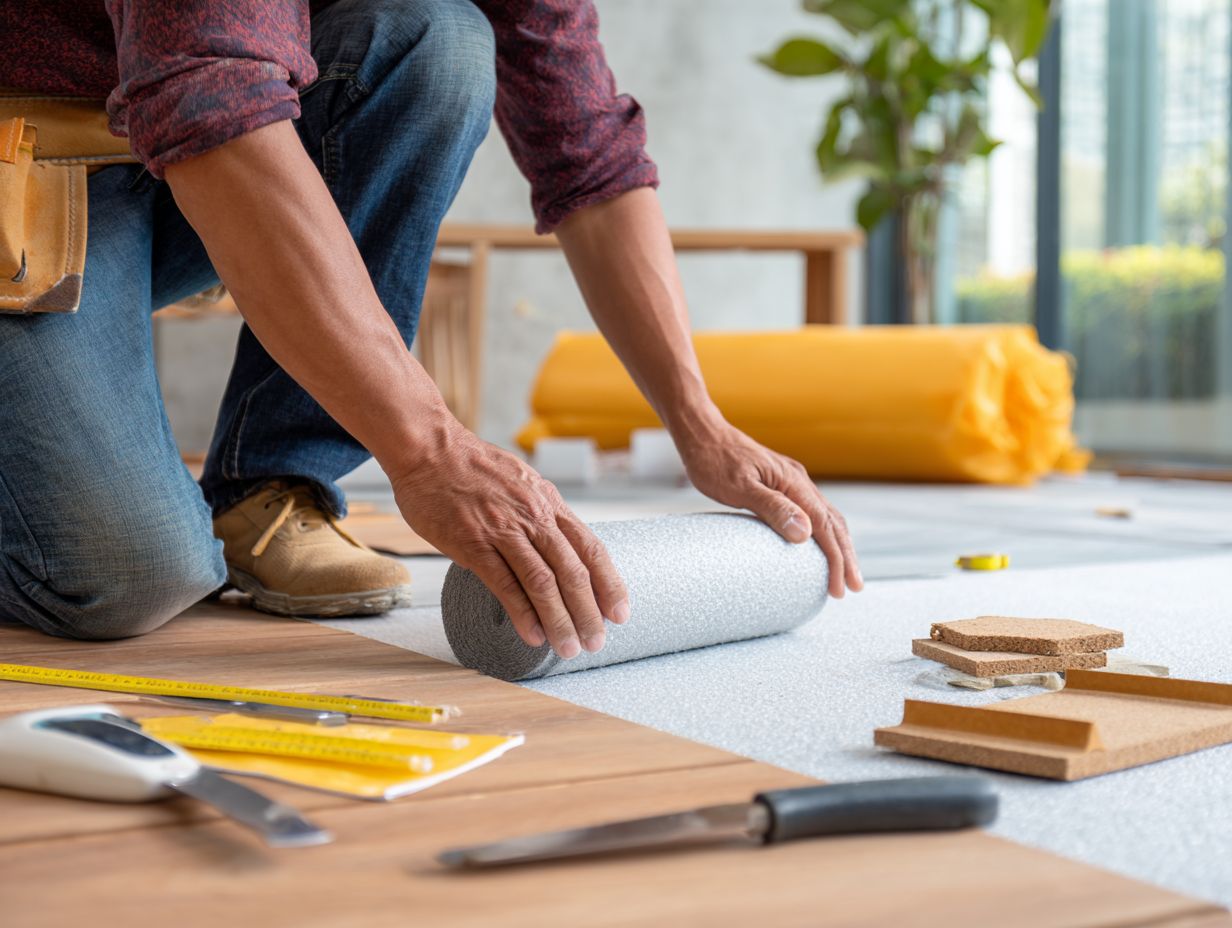
Felt underlayment provides a reliable moisture barrier and is often used with hardwood flooring installations, helping to maintain the integrity of the floor over time.
This underlayment typically costs between $0.40 and $0.80 per square foot, making it a cheap option for controlling moisture.
It works exceptionally well with various flooring types, including laminate and engineered wood. When installing, make sure the subfloor is clean and dry for best results. Consider overlapping seams to prevent moisture leaks.
Felt underlayment helps reduce noise, improving the comfort of the area, especially useful in buildings with multiple floors.
Plastic Underlayment
Plastic underlayment serves as an effective moisture control layer, particularly in areas prone to dampness, and is compatible with radiant heat flooring systems.
Typically priced between $0.30 and $0.70 per square foot, plastic underlayment offers a cost-effective solution for moisture management. It effectively blocks moisture from penetrating flooring, which is especially beneficial in basements or bathrooms.
To install correctly, make sure the subfloor is clean and dry. Lay the underlayment in the same direction as the flooring and overlap the seams by a few inches.
Pressing down with a heavy rolling pin gets rid of air bubbles, resulting in a smoother floor that is more durable.
Choosing the Right Underlayment
Picking the right underlayment involves considering the flooring type, the conditions it will endure, and the budget for effective performance.
Considerations for Different Flooring Types
When choosing underlayment, make sure to pick one that fits the flooring material because different floor types need different support and offer various advantages.
For hardwood, a premium foam underlayment helps reduce noise and moisture, enhancing durability.
Laminate flooring often pairs well with a standard foam or cork underlayment, which offers cushioning and sound absorption.
Vinyl, on the other hand, usually requires a moisture barrier underlayment to prevent damage from moisture seepage.
Assess your room’s conditions-such as moisture levels and foot traffic-to choose the right underlayment. This setup increases the lifespan of your flooring, improves comfort, and provides better insulation.
Moisture Resistance and Soundproofing
It’s important to choose an underlayment that resists moisture and blocks sound to make sure your flooring lasts a long time and feels comfortable.
For moisture resistance, consider using products like cork underlayment, which naturally repels water, or polyethylene foam, known for its effective moisture barrier properties. Both are excellent choices for areas prone to humidity, like basements. To explore how moisture barriers can optimize flooring over concrete slabs, our deep dive into moisture barriers for concrete flooring provides detailed insights.
To improve soundproofing, consider using mineral wool underlayment or rubber, as they greatly cut down on noise transmission. Combining these materials can provide both benefits; for instance, using cork underneath rubber can effectively manage moisture while absorbing sound.
Selecting the right combination based on specific environmental conditions will lead to improved flooring longevity and comfort.
Cost and Availability
Knowing the price and supply of different underlayment choices is important for homeowners and contractors to plan their spending on flooring work.
Common underlayment types include:
- Foam
- Cork
- Rubber
each varying in cost and utility.
Foam underlayment typically ranges from $0.30 to $0.80 per square foot and is often available at retailers like Home Depot and Lowe’s.
Cork, while offering better sound insulation, costs about $1.50 to $2.50 per square foot and can also be found in specialty flooring stores.
Rubber underlayment is the priciest option, averaging $2 to $4 per square foot, yet excels in moisture resistance.
To get the most benefit, think about buying in large quantities or looking for discounts during less busy times.
Preparation for Installation
Getting the subfloor ready before putting down the underlayment is important for a successful flooring job and helps avoid problems later on.
Tools and Materials Needed
A successful underlayment installation requires specific tools and materials, ensuring efficiency and effectiveness in the process.
Key tools are:
- A utility knife for clean cuts
- A measuring tape for exact measurements
- The right flooring adhesive for your material choice
Using a straight edge helps keep lines neat when cutting, and a roller can help spread adhesive evenly. Use a moisture meter to check for dampness in basements to prevent problems later on.
Getting your workspace ready in advance can make setting things up much easier and quicker.
Subfloor Assessment
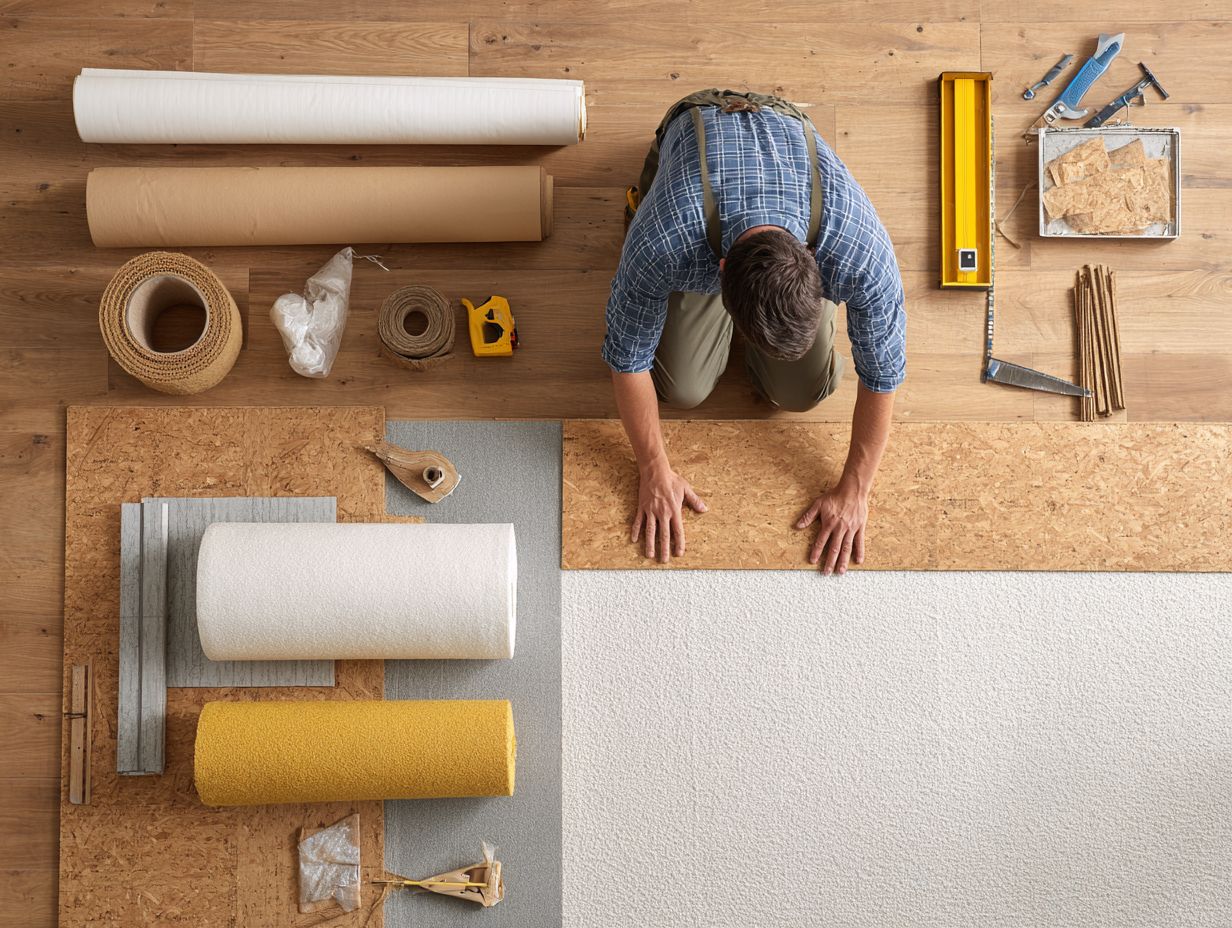
Checking the subfloor is an important part of getting ready, because any uneven areas can affect how the flooring and underlayment work.
- Begin by checking the flatness with a 10-foot straight edge; any deviations over 1/8 inch could indicate issues.
- Next, use a moisture meter to check that the moisture level is below 12% for most flooring types.
- If you find issues, you can even out the subfloor with a self-leveling compound or swap out damaged parts.
- To deal with moisture problems, think about installing a vapor barrier or changing the room’s ventilation to stop problems from happening later.
- Regular assessments can prolong your flooring’s life and maintain its appearance.
Cleaning and Leveling the Subfloor
Cleaning and leveling the subfloor before underlayment installation is essential to create a solid foundation for the flooring materials.
- Start by removing all furniture and debris from the area.
- Sweep and vacuum the subfloor thoroughly to eliminate dust and particles.
- Next, inspect for any uneven sections; a leveling compound can easily address minor dips.
- Mix and pour this compound according to the manufacturer’s instructions, using a trowel to spread it evenly.
- For deeper imperfections, consider using shims to raise low spots.
- Allow it to cure fully before proceeding.
Getting your new floors ready usually takes a few hours, but it makes them last longer and look polished.
Installation Methods
There are different ways to install underlayment, and each has its own benefits depending on the type of flooring and project needs.
Roll Out Method
The roll-out method involves unrolling a continuous sheet of underlayment across the subfloor, simplifying installation for larger areas.
This technique is advantageous as it minimizes seams, reducing potential moisture infiltration and enhancing insulation. You should overlap seams by at least 6 inches and stagger them for even distribution.
Applying a moisture barrier can further protect against water damage. The roll-out method is particularly effective in basements or large living spaces where traditional methods might be cumbersome, allowing for a quicker installation process while still providing a solid foundation for flooring.
Tile Method
This method uses square tiles to cover small or tricky areas accurately.
To effectively use this method, start by measuring your area to determine the number of tiles needed, ensuring to account for waste.
Begin installation at the center of the room, moving outward to maintain symmetry. Use a level to make sure it is straight, and consider using adhesive options like thin-set mortar for more stability.
This method works well in rooms with odd shapes, where accuracy is important for a smooth result. Opting for tiles with interlocking edges can further simplify alignment, enhancing durability.
Click and Lock Method
The click and lock installation method is designed for interlocking underlayment panels that fit together without additional adhesives, ideal for DIY projects.
To install using the click and lock method, begin by ensuring your subfloor is clean and level. Lay down the underlayment, then start placing the interlocking panels at one corner, angling the tongue of one panel into the groove of the adjacent panel until it clicks into place.
This design allows for easy removal and repositioning if needed. Benefits of this method include:
- Faster installation
- No glue mess
- Perfect for home projects where flexibility is important
Common Mistakes to Avoid
To make sure your flooring project goes well and to avoid expensive repairs later, stay away from typical errors during underlayment installation. For more detailed guidance, refer to our Floating Floor Installation – Complete Step-by-Step Guide.
Improper Alignment
Improper alignment of underlayment can lead to gaps and uneven flooring, impacting both aesthetics and performance.
To install it properly, start by accurately measuring your area. Use a chalk line to create straight reference lines on the subfloor, ensuring that each panel will align properly.
During installation, lay the underlayment perpendicular to the intended flooring direction and leave a gap of about 1/4 inch around edges to allow for expansion. Regularly check alignment and adjust as necessary before securing.
Keep in mind that carefully setting up your flooring can help avoid expensive errors and make it last longer.
Neglecting Moisture Barriers
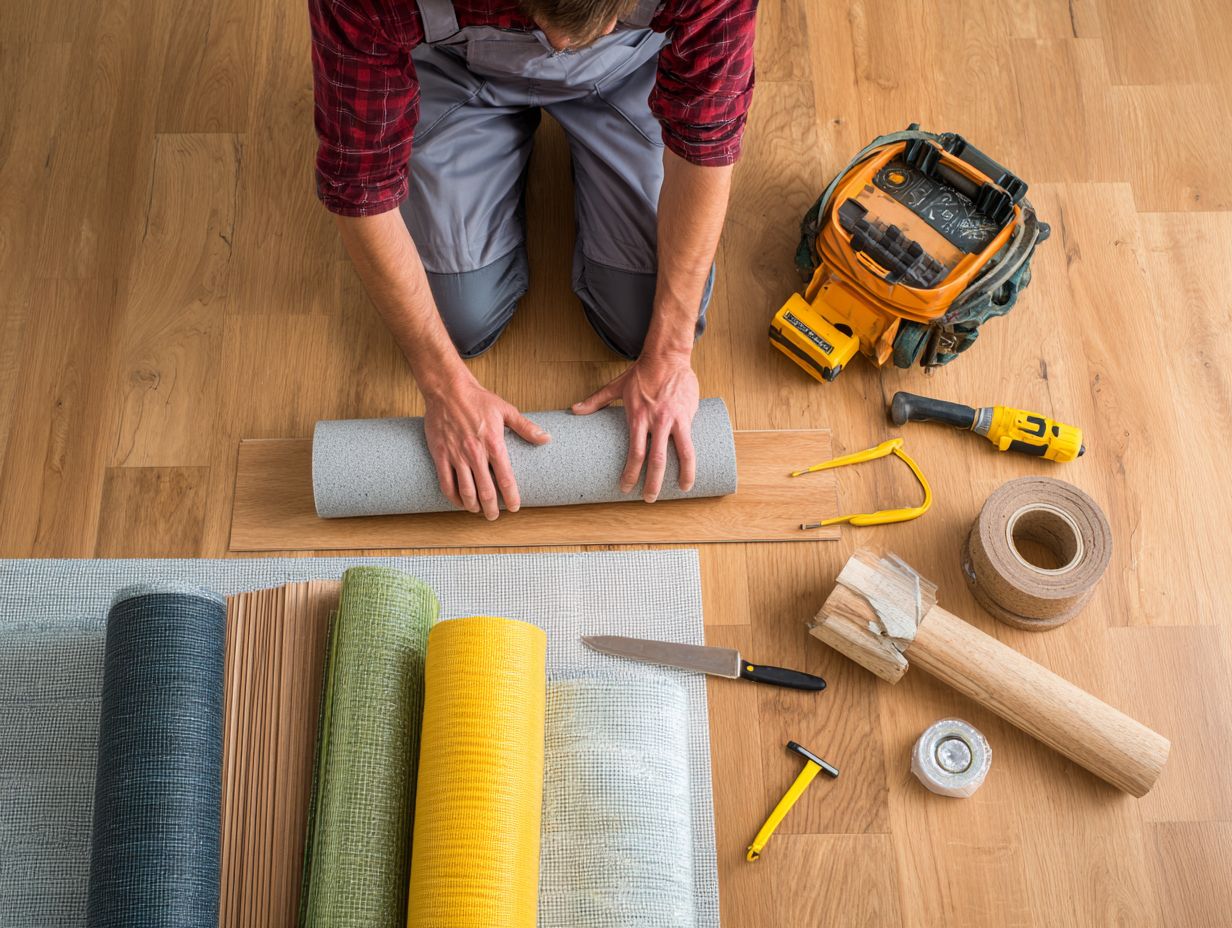
Neglecting to install moisture barriers can result in long-term damage to the flooring and subfloor, particularly in humid environments.
To select an effective moisture barrier, look for materials like 6-mil polyethylene sheeting or specialized underlayment products designed for moisture resistance.
When setting it up, make sure the barrier covers the seams and goes up the walls to form an unbroken layer. Tape down joints to prevent moisture infiltration.
Always consult local building codes to guarantee compliance, as requirements may vary significantly by region. A correctly installed barrier can greatly increase the lifespan of your flooring, shielding it from problems caused by moisture.
Frequently Asked Questions
What is flooring underlayment and why is it important for installation?
Flooring underlayment is a layer of material that is placed between the subfloor and the flooring material. It is important because it helps to create a smooth and stable surface for the flooring to be installed on, as well as providing insulation and soundproofing.
What are the different types of flooring underlayment?
Some common types of flooring underlayment are cork, rubber, foam, and plywood. Each type has its own benefits and is suitable for different types of flooring, such as hardwood, laminate, or carpet.
What are the benefits of using cork underlayment?
Cork underlayment is a natural and eco-friendly option that provides excellent soundproofing, insulation, and moisture resistance. It is also easy to install and can be used under all types of flooring.
Can I install flooring underlayment myself?
Yes, many types of underlayment are designed for easy do-it-yourself installation. However, make sure to follow the manufacturer’s instructions and collect all necessary tools and materials before beginning the installation.
What is the difference between floating and attached underlayment?
Floating underlayment is not attached to the subfloor and is typically made of lightweight materials, while attached underlayment is secured to the subfloor with nails or adhesives and is usually made of denser materials. The choice between the two depends on the type of flooring and subfloor being used.
How do I know which type of underlayment is best for my flooring?
The best type of underlayment for your flooring will depend on the type of flooring being installed, the condition of your subfloor, and any specific needs for soundproofing or insulation. It is recommended to consult with a flooring professional to determine the most suitable option for your specific project.
